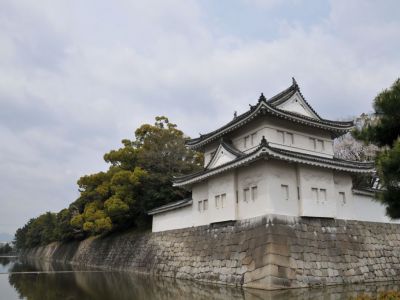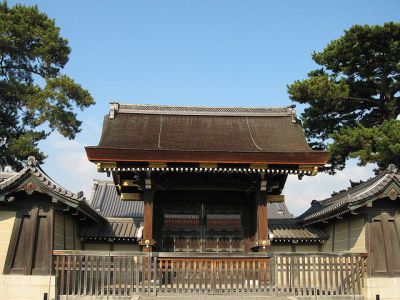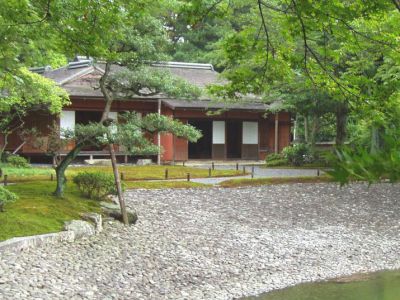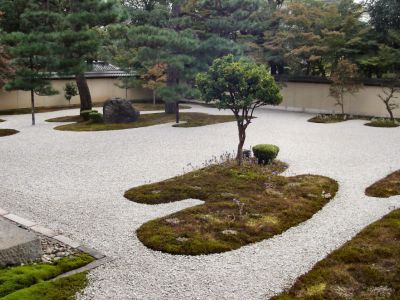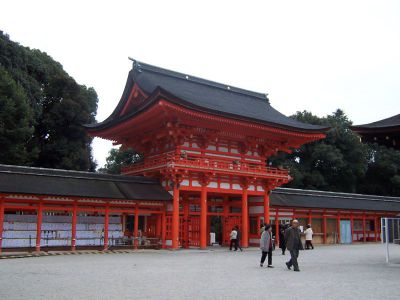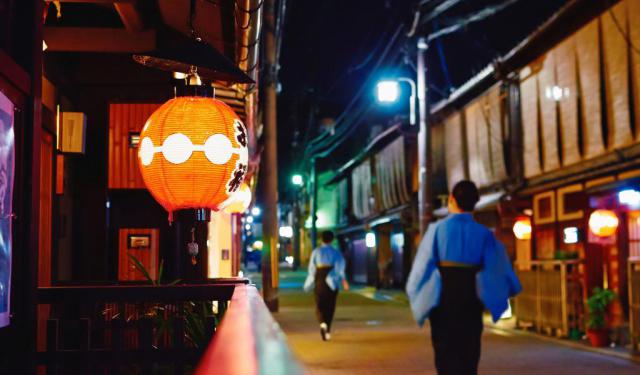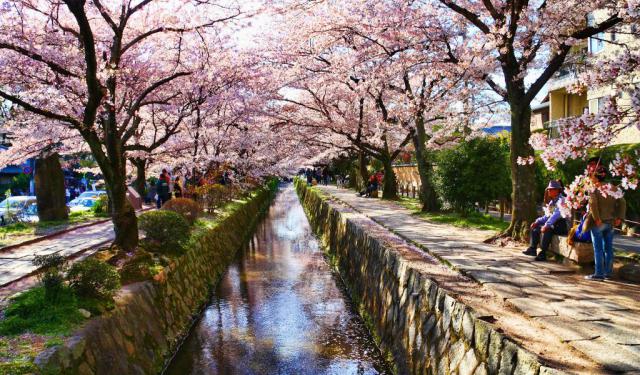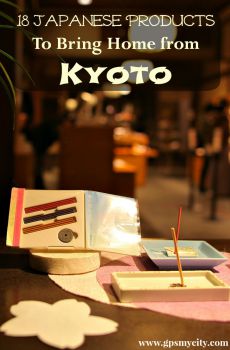
Imperial Kyoto Walking Tour (Self Guided), Kyoto
The former capital of Japan, Kyoto is the city of tradition. During its heyday, Imperial Kyoto was the cultural and political heart of the country. At the heart of its historical landscape, there are several iconic landmarks, each bearing witness to the city's imperial past.
Nijo Castle, an architectural marvel renowned for its elegant design and elaborate gardens, boasts impeccably maintained moats and stone walls. Once a strategic base for the Tokugawa shoguns, its grandeur embodies a fusion of imperial and shogunate influence.
Further ahead sprawls the Kyoto Imperial Palace, a symbol of royal authority and tradition. This vast complex, encompassing lush gardens and majestic halls, once exclusive to the emperor and his entourage, today is transformed into a public space.
Right next to it, set amidst tranquil surroundings, is the former retirement residence for emperors, the Sento Palace. This serene retreat provided a sanctuary for emperors seeking respite from the demands of governance, and today it serves as a Kyoto abode for the Japanese Imperial family.
Situated east of the Imperial Palace, Rozan-ji Temple stands as a bastion of spiritual solace. Founded in the 10th century, this historical property was untouched by war and now boasts a rich heritage, including the graves of Edo period nobility and a serene garden, while hosting traditional annual ceremonies.
Nestled in the verdant forest, Shimogamo-Jinja Shrine exudes an aura of ancient mysticism. This is one of the city's oldest sacred grounds – dedicated to the gods of nature – and is a UNESCO World Heritage Site.
As we reflect on the splendor of Imperial Kyoto and its enduring legacy, let us heed the call to explore these hallowed grounds. Our self-guided tour offers you a chance to immerse yourself in the grandeur of imperial times and feel the breath of Japan's antiquity firsthand.
Nijo Castle, an architectural marvel renowned for its elegant design and elaborate gardens, boasts impeccably maintained moats and stone walls. Once a strategic base for the Tokugawa shoguns, its grandeur embodies a fusion of imperial and shogunate influence.
Further ahead sprawls the Kyoto Imperial Palace, a symbol of royal authority and tradition. This vast complex, encompassing lush gardens and majestic halls, once exclusive to the emperor and his entourage, today is transformed into a public space.
Right next to it, set amidst tranquil surroundings, is the former retirement residence for emperors, the Sento Palace. This serene retreat provided a sanctuary for emperors seeking respite from the demands of governance, and today it serves as a Kyoto abode for the Japanese Imperial family.
Situated east of the Imperial Palace, Rozan-ji Temple stands as a bastion of spiritual solace. Founded in the 10th century, this historical property was untouched by war and now boasts a rich heritage, including the graves of Edo period nobility and a serene garden, while hosting traditional annual ceremonies.
Nestled in the verdant forest, Shimogamo-Jinja Shrine exudes an aura of ancient mysticism. This is one of the city's oldest sacred grounds – dedicated to the gods of nature – and is a UNESCO World Heritage Site.
As we reflect on the splendor of Imperial Kyoto and its enduring legacy, let us heed the call to explore these hallowed grounds. Our self-guided tour offers you a chance to immerse yourself in the grandeur of imperial times and feel the breath of Japan's antiquity firsthand.
How it works: Download the app "GPSmyCity: Walks in 1K+ Cities" from Apple App Store or Google Play Store to your mobile phone or tablet. The app turns your mobile device into a personal tour guide and its built-in GPS navigation functions guide you from one tour stop to next. The app works offline, so no data plan is needed when traveling abroad.
Imperial Kyoto Walking Tour Map
Guide Name: Imperial Kyoto Walking Tour
Guide Location: Japan » Kyoto (See other walking tours in Kyoto)
Guide Type: Self-guided Walking Tour (Sightseeing)
# of Attractions: 5
Tour Duration: 2 Hour(s)
Travel Distance: 4.1 Km or 2.5 Miles
Author: emma
Sight(s) Featured in This Guide:
Guide Location: Japan » Kyoto (See other walking tours in Kyoto)
Guide Type: Self-guided Walking Tour (Sightseeing)
# of Attractions: 5
Tour Duration: 2 Hour(s)
Travel Distance: 4.1 Km or 2.5 Miles
Author: emma
Sight(s) Featured in This Guide:
- Nijo Castle
- Kyoto Imperial Palace
- Sento Imperial Palace
- Rozan-ji Temple
- Shimogamo-Jinja Shrine
1) Nijo Castle (must see)
The moat and stone walls are impeccably maintained, though compared to castles elsewhere, their dimensions are relatively modest. However, what lies within is a palace renowned for its exceptional artwork. Established in 1603, the castle served not as a display of military might, but rather as a strategic base from which the Tokugawa shoguns could oversee the emperor.
Upon entering, visitors are guided through a magnificent Chinese-style gate leading to the Ninomaru Palace. Built in 1626 for a ceremonial visit by the emperor, it symbolized a unification of imperial and shogunate factions, prompting the employment of top artists of the era to adorn its rooms. Additionally, these were intended to serve as the shogun's residence in Kyoto.
Comprising five interconnected buildings arranged hierarchically, the palace delineates spaces for functionaries, Outer Lords, Tokugawa allies, and private chambers. A unique feature is the Nightingale Corridor, which functions as an alarm system by emitting squeaks when walked upon, safeguarding the palace's wealth of artwork, including over 1,000 paintings. Noteworthy among them are depictions of sturdy pine trees, symbolizing Tokugawa power.
Adjacent to the palace lies a pond garden featuring rugged rocks evoking military strength. The path encircling the grounds leads past an ancient villa, scenic viewpoints, and tea houses. Abundant cherry trees dot the landscape, particularly enchanting when illuminated during springtime. Together, the castle and cherry blossoms conjure images of samurai and fleeting beauty, offering a profound connection to the essence of Japanese culture here at Nijo.
Tips:
Be sure to wear socks, as shoes must be removed to explore the interior. For a deeper understanding of the complex's history, consider renting audio guide headphones. Alternatively, you can join the English language tour, which runs daily at 10 AM and 12:30 PM.
Upon entering, visitors are guided through a magnificent Chinese-style gate leading to the Ninomaru Palace. Built in 1626 for a ceremonial visit by the emperor, it symbolized a unification of imperial and shogunate factions, prompting the employment of top artists of the era to adorn its rooms. Additionally, these were intended to serve as the shogun's residence in Kyoto.
Comprising five interconnected buildings arranged hierarchically, the palace delineates spaces for functionaries, Outer Lords, Tokugawa allies, and private chambers. A unique feature is the Nightingale Corridor, which functions as an alarm system by emitting squeaks when walked upon, safeguarding the palace's wealth of artwork, including over 1,000 paintings. Noteworthy among them are depictions of sturdy pine trees, symbolizing Tokugawa power.
Adjacent to the palace lies a pond garden featuring rugged rocks evoking military strength. The path encircling the grounds leads past an ancient villa, scenic viewpoints, and tea houses. Abundant cherry trees dot the landscape, particularly enchanting when illuminated during springtime. Together, the castle and cherry blossoms conjure images of samurai and fleeting beauty, offering a profound connection to the essence of Japanese culture here at Nijo.
Tips:
Be sure to wear socks, as shoes must be removed to explore the interior. For a deeper understanding of the complex's history, consider renting audio guide headphones. Alternatively, you can join the English language tour, which runs daily at 10 AM and 12:30 PM.
2) Kyoto Imperial Palace (must see)
Not too far from the bustling heart of Kyoto lies a vast expanse of greenery, home to a staggering 50,000 trees. Stretching nearly a mile in length, this rectangular plot of land was once the exclusive domain of the emperor and his entourage, complete with 200 fancy noble houses. But when the capital packed up and moved to Tokyo in 1868, this area fell into disuse. Thankfully, it's now preserved for the enjoyment of the public, though it still plays host to various ceremonies like the coronation of a new emperor.
Now, here's the kicker: the emperor's old stomping grounds, known as Gosho, are now open to the public! Visitors can wander around the wooden buildings, soaking in the ambiance of symbolic authority. Lacking any fortifications, these buildings blend seamlessly with their surroundings, practically inviting the outdoors in with their sliding panels opening onto verandas overlooking a serene pond garden.
Originally constructed in 794, the current setup dates to 1855 after a series of unfortunate fires. Enclosed by a wall and crisscrossed with gravel pathways, the palace retains its essence—think low, sweeping rooflines and lots of wood—but it's been given a modern makeover.
As for exploring, you have options: follow the simple route marked with English signage or join a free guided tour in English (lasting an hour at 10 AM and 2 PM) at the Imperial Household Office in the park's northeastern corner. Just don't forget your passport—it's your ticket to join one of these tours!
Now, here's the kicker: the emperor's old stomping grounds, known as Gosho, are now open to the public! Visitors can wander around the wooden buildings, soaking in the ambiance of symbolic authority. Lacking any fortifications, these buildings blend seamlessly with their surroundings, practically inviting the outdoors in with their sliding panels opening onto verandas overlooking a serene pond garden.
Originally constructed in 794, the current setup dates to 1855 after a series of unfortunate fires. Enclosed by a wall and crisscrossed with gravel pathways, the palace retains its essence—think low, sweeping rooflines and lots of wood—but it's been given a modern makeover.
As for exploring, you have options: follow the simple route marked with English signage or join a free guided tour in English (lasting an hour at 10 AM and 2 PM) at the Imperial Household Office in the park's northeastern corner. Just don't forget your passport—it's your ticket to join one of these tours!
3) Sento Imperial Palace
The Sento Imperial Palace, also known as Sento Gosho, once served as the retirement residence for emperors, with its origins dating back to 1630 when it was constructed for Emperor Go-Mizunoo. Despite enduring a devastating fire two centuries later, it still stands as the Kyoto abode for the Imperial family. Surrounding the palace is a sprawling 22-acre garden, enclosed by an ancient mud wall. To explore this verdant expanse, visitors must join a free tour organized by the Imperial Household Agency and pass through a stately wooden gate.
The garden, highly esteemed for its scenic beauty, features a winding path that leads past quaint tea houses, with the most notable feature being a shoreline meticulously crafted from individual pebbles lining the edge of a tranquil pond. Though the tours are conducted solely in Japanese, audio guides in various foreign languages are available to enhance the experience. Some structures, like the Seikatei teahouse, are left open for visitors to peek inside and appreciate the imperial architectural style.
But there's more to this area than just aristocratic estates. Amidst the towering pines and cedars, one can find delightful groves of plum and cherry trees. Additionally, scattered throughout are shrines and spaces for recreational activities such as tennis and baseball. Dog walkers and birdwatchers frequent the area year-round, as this oasis of green space in the heart of the city serves as a beloved refuge, perhaps offering solace for the absent emperor.
The garden, highly esteemed for its scenic beauty, features a winding path that leads past quaint tea houses, with the most notable feature being a shoreline meticulously crafted from individual pebbles lining the edge of a tranquil pond. Though the tours are conducted solely in Japanese, audio guides in various foreign languages are available to enhance the experience. Some structures, like the Seikatei teahouse, are left open for visitors to peek inside and appreciate the imperial architectural style.
But there's more to this area than just aristocratic estates. Amidst the towering pines and cedars, one can find delightful groves of plum and cherry trees. Additionally, scattered throughout are shrines and spaces for recreational activities such as tennis and baseball. Dog walkers and birdwatchers frequent the area year-round, as this oasis of green space in the heart of the city serves as a beloved refuge, perhaps offering solace for the absent emperor.
4) Rozan-ji Temple
The Rozan-ji Temple is located to the East of the Imperial Palace in Kyoto on the site of a former mansion that belonged to the father of Murasaki Shikibu, a noblewoman who went down in history as the author of the epic 11th century novel, The Tale of Genji. Many visitors come here regularly to pay homage to Lady Murasaki.
The temple was constructed in the year 938 on a hill, called Funaokayama, by the Buddhist priest Ganzan Daishi. In 1571, many of the local temples were burned down by the warlord Oda Nobunaga. Unlike those unfortunate ones, the Rozan-ji temple escaped destruction. Emperor Kokaku commissioned its expansion and the work at its present site started soon after.
Today, Rozan-ji is the final resting place of numerous princes, princesses and other prominent personalities from the Edo period. Among them is Jocho Busshi, the renowned Heian-era sculptor, maker of Buddhist statuary. Fronting the temple is a small moss and gravel garden with beautiful bellflower plants. The Day of Setsubun, a traditional annual court ceremony of driving out demons, is performed here on the 2nd and 3rd of February.
The temple was constructed in the year 938 on a hill, called Funaokayama, by the Buddhist priest Ganzan Daishi. In 1571, many of the local temples were burned down by the warlord Oda Nobunaga. Unlike those unfortunate ones, the Rozan-ji temple escaped destruction. Emperor Kokaku commissioned its expansion and the work at its present site started soon after.
Today, Rozan-ji is the final resting place of numerous princes, princesses and other prominent personalities from the Edo period. Among them is Jocho Busshi, the renowned Heian-era sculptor, maker of Buddhist statuary. Fronting the temple is a small moss and gravel garden with beautiful bellflower plants. The Day of Setsubun, a traditional annual court ceremony of driving out demons, is performed here on the 2nd and 3rd of February.
5) Shimogamo-Jinja Shrine
Shimogamo-Jinja is one of the oldest shrines in Kyoto and one of the 17 monuments in the old city declared World Heritage Sites by the UNESCO.
The shrine dates back to the 6th century and was originally constructed to protect the city of Kyoto. It is located within a forest, called Tadasu no Mori (the “Forest of Truth”), and is dedicated to the deities Kamotaketsunumi-no-Mikoto and his daughter Tamayorihime-no-Mikoto, as well as to the God of Fire and Thunder, Honoikazuchi-no-Mikoto. The shrine received imperial patronage during the Haien Era and from 1871 to 1946, being a Kanpei-Taisha or government-supported shrine of the first rank.
Shimogamo-Jinja is famous for the annual Aoi Matsuri (“Hollyhock”) Festival that takes place on May 15th. It is also the site of an annual New Year Ritual, called Kemari Hajime. Kemari is a traditional Japanese sport originated in the Haien Era. It had almost disappeared after the Meiji Restoration but was revived by the efforts of the Kemari Preservation Society in 1903. The Tadasu no Mori surrounding the shrine is a green oasis of tranquility amid the bustling metropolis. The park has many ancient and beautiful trees, is crisscrossed by clear streams, and has been regarded as an important Haien-era botanical garden.
Why You Should Visit:
The shrine itself is not big, but the surrounding it park-like area offers a pleasant respite in the shade of old trees.
The tall bamboo is peaceful and a very nice alternative to the usually crowded bamboo grove in Arashiyama.
Tip:
Any festival held here has some interesting traditions to it, so it's probably best to visit here with a knowledgeable guide to explain them.
The shrine dates back to the 6th century and was originally constructed to protect the city of Kyoto. It is located within a forest, called Tadasu no Mori (the “Forest of Truth”), and is dedicated to the deities Kamotaketsunumi-no-Mikoto and his daughter Tamayorihime-no-Mikoto, as well as to the God of Fire and Thunder, Honoikazuchi-no-Mikoto. The shrine received imperial patronage during the Haien Era and from 1871 to 1946, being a Kanpei-Taisha or government-supported shrine of the first rank.
Shimogamo-Jinja is famous for the annual Aoi Matsuri (“Hollyhock”) Festival that takes place on May 15th. It is also the site of an annual New Year Ritual, called Kemari Hajime. Kemari is a traditional Japanese sport originated in the Haien Era. It had almost disappeared after the Meiji Restoration but was revived by the efforts of the Kemari Preservation Society in 1903. The Tadasu no Mori surrounding the shrine is a green oasis of tranquility amid the bustling metropolis. The park has many ancient and beautiful trees, is crisscrossed by clear streams, and has been regarded as an important Haien-era botanical garden.
Why You Should Visit:
The shrine itself is not big, but the surrounding it park-like area offers a pleasant respite in the shade of old trees.
The tall bamboo is peaceful and a very nice alternative to the usually crowded bamboo grove in Arashiyama.
Tip:
Any festival held here has some interesting traditions to it, so it's probably best to visit here with a knowledgeable guide to explain them.
Walking Tours in Kyoto, Japan
Create Your Own Walk in Kyoto
Creating your own self-guided walk in Kyoto is easy and fun. Choose the city attractions that you want to see and a walk route map will be created just for you. You can even set your hotel as the start point of the walk.
Higashiyama Walking Tour
Kyoto is a city catering to tourists, especially those who love history, religion, and, of course, Japanese culture. Many of Kyoto's attractions are found in the eastern part of the city, which itself is split into wards. One of them is the Higashiyama Ward, home to several famous temples, where the look and the feel of feudal-era Japan are still preserved.
One of Higashiyama's most... view more
Tour Duration: 1 Hour(s)
Travel Distance: 2.6 Km or 1.6 Miles
One of Higashiyama's most... view more
Tour Duration: 1 Hour(s)
Travel Distance: 2.6 Km or 1.6 Miles
Kyoto Shopping and Food Tour
The cultural capital of Japan, Kyoto is just as famous as a shopper’s paradise and, without a doubt, the best place in the country to buy traditional and modern Japanese goods. Souvenirs, food, bargains, and various “one-of-a-kind items” are all up for grabs here.
In addition to its shopping scene, Kyoto boasts a rich culinary heritage, from Michelin-starred restaurants to humble street... view more
Tour Duration: 1 Hour(s)
Travel Distance: 2.0 Km or 1.2 Miles
In addition to its shopping scene, Kyoto boasts a rich culinary heritage, from Michelin-starred restaurants to humble street... view more
Tour Duration: 1 Hour(s)
Travel Distance: 2.0 Km or 1.2 Miles
Gion District Walking Tour
Famed as one of the most mesmerizing parts of Kyoto, Gion has long been associated with traditional Japanese entertainment, stunning temples, geishas, and local eateries, ideal for whiling away a day in the ancient capital of Japan. This district forms part of the Higashiyama (“Eastern Mountain”) neighborhood.
Among its notable landmarks is the Minamiza Kabuki Theater, a venue where... view more
Tour Duration: 2 Hour(s)
Travel Distance: 2.8 Km or 1.7 Miles
Among its notable landmarks is the Minamiza Kabuki Theater, a venue where... view more
Tour Duration: 2 Hour(s)
Travel Distance: 2.8 Km or 1.7 Miles
Arashiyama and Bamboo Grove Walking Tour
The Arashiyama district of Kyoto is slightly out of the way for tourists, but that means you can enjoy it more comfortably.
Undoubtedly, the most popular attraction here is the iconic Bamboo Grove, a mesmerizing forest of towering bamboo stalks that sway gently in the breeze, creating an ethereal atmosphere. This serene setting is a must-visit for travelers seeking tranquility amidst... view more
Tour Duration: 2 Hour(s)
Travel Distance: 3.4 Km or 2.1 Miles
Undoubtedly, the most popular attraction here is the iconic Bamboo Grove, a mesmerizing forest of towering bamboo stalks that sway gently in the breeze, creating an ethereal atmosphere. This serene setting is a must-visit for travelers seeking tranquility amidst... view more
Tour Duration: 2 Hour(s)
Travel Distance: 3.4 Km or 2.1 Miles
Walk on Philosopher's Path
The Philosopher's Path in Kyoto winds its way for about 2 km along the canal that carries water from Lake Biwa to the foothills. Lined with cherry trees, this picturesque walking trail was named in honor of the famed Japanese philosopher, Nishida Kitaro, who used to walk here as a part of his daily meditation in the first half of the 20th century. A popular spot for both locals and tourists,... view more
Tour Duration: 2 Hour(s)
Travel Distance: 2.7 Km or 1.7 Miles
Tour Duration: 2 Hour(s)
Travel Distance: 2.7 Km or 1.7 Miles
Useful Travel Guides for Planning Your Trip
18 Japanese Products To Bring Home from Kyoto
The old capital of Japan, the city of Kyoto has once again been the talk of the world lately, thanks to the bestselling "Memoirs of a Geisha" book and the namesake Hollywood blockbuster movie. Renowned for its impeccable craftsmanship, Japan has so much to amaze a foreign eye with. Many of...
The Most Popular Cities
/ view all
